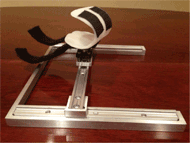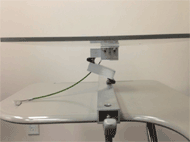iDEA – iPad Dexterity Enhancement Apparatus (Loyola Marymount University)
Ed Gillman, Amy Clancy, Ann Marie Gelle, Teresa Nguyen
 Content for id "Hero" Goes Here
Content for id "Hero" Goes HereABSTRACT
Cerebral Palsy (CP) is a common congenital disorder that damages the brain and inhibits motor movement and control. Aside from physical therapy, there are not any remedies for the lack of muscle coordination. Because CP already reduces muscle tone, it is important for assistive devices to improve motor movement without eliminating muscle use entirely. Our client, Abbie, is a 5-year-old kindergarten student who, as a result of CP, struggles with the fine motor movement required to use her iPad for communication. Our project’s goal is to provide Abbie with the fundamental support and control needed to operate an iPad more effectively. The final design, called the iDEA, is essentially a supportive, spring loaded tracking system that keeps her hand in the optimal operating position while supporting her wrist to prevent hand dragging. It allows her to use her natural tapping motion, but with enhanced control and guided dexterity.
YouTube video at http://youtu.be/2qezciT9_3gINTRODUCTION
Cerebral Palsy (CP) is one of the most common congenital (existing before or at birth) disorders of childhood. Due to the effect on the brain, CP makes muscle function and coordination difficult. People with CP have trouble controlling certain muscles and lack the fine motor movement required for writing, drawing, and using general technological applications. These setbacks are often detrimental to their education, so it is important to develop the muscles required for fine motor movement.
Our client, Abbie, is a 5-year-old student at WISH Charter Elementary School in Westchester, California. She suffers from Cerebral Palsy and therefore struggles to participate in kindergarten activities such as drawing and writing. After several observations, it was determined that she tends to drag her hand on the desk when she is writing and has trouble pinpointing specific locations on the paper. Additionally, muscle spasms often cause her entire arm to flinch. She recently received an iPad to use in class and at home for learning and communication. Since her hand usually drags during movement, she tends to accidentally touch the iPad surface and select the wrong item. Our innovative design, the iDEA, will focus on improving her iPad performance. The goal of the device is to stabilize her forearm, support her wrist, and keep her hand on a level plane optimal for using the iPad.
Currently, the market has several assistive technologies that improve tablet operation. Most of the devices are special mounting arms that allow the user to adjust the tablet to a comfortable position and orientation. However, the Wilmington Robotic Exoskeleton (WREX) has combined 3D printing with resistive bands to create a fully customizable pediatric prosthetic. This technology is exciting, but is intended for users that have little to no ability to use their arms. The goal of the iDEA is to improve users’ dexterity without limiting their natural muscle movement.
DESIGN REQUIREMENTS
The self-imposed requirements for the design are as follows:
Wrist/Hand Assistance
Portability:
System will easily fixate to any surface (desk, table, etc.) and detach without damaging the surface. Additionally, system will weigh less than two pounds.
Range of motion:
System will not limit the user’s range of motion. User will be able to move in x, y, and z directions and rotate arm 180 degrees along the surface.
Drag prevention:
System will support user’s wrist and provide enough resistance to prevent user’s hand from dragging on surface.
Cost:
System will cost less than $200.
Comfort:
System will not cause muscle strain or discomfort for the user.
Desk Framing
Mounting Mechanism:
System should attach to wheelchair using the existing clamping mechanism.
Range of Motion/Tilt Angle:
System should be able to move towards, away, and at an angle to better adhere to user’s comfort.
DESIGN CONCEPT
The foundation of the iDEA is a system of rails and carriages as seen in Figure 1 below. An aluminum, “C” shaped frame houses the rails in the proper orientation and alignment. The frame has tapped holes for the rails to screw into. One long rail is attached on each end to carriages running inside two shorter rails. This allows for the long rail to move laterally along the surface. Another carriage runs inside the long rail, allowing lateral movement up and down the rail.
A platform, with four springs, is mounted onto the carriage running inside the long rail. As displayed in Figure 2, these springs allow the user to push their wrist downward, and thereby closer to the work surface, with slight resistance. It still allows the user to make natural tapping motions, but in a more controlled manner. Additionally, the springs allow the entire platform to bend in every direction and thus improve comfort.
Another platform is positioned at the top of the springs. Made from low-friction delrin, it acts as a bushing for the shaft fed through its center. The shaft is threaded on one end so that it can screw into tapped holes. Using Inventables Hand Moldable Plastic, a plastic wrist support was customized to the user’s specific dimensions. The plastic can be melted and reformed as necessary. A threaded insert was then heat-set into the plastic and allows the shaft to screw into the wrist support simply and securely. Once screwed onto the shaft, the entire wrist support can rotate 360 degrees. As shown in Figure 3, the assembled iDEA permits controlled, stable user movement in every direction.
Once assembled, the iDEA is easily fixed to any surface using Inventables Suction Cup Tape. One side of the tape is adhesive and the other consists of hundreds of micro-suction cups. When pressed onto a flat surface, the suction cups hold firmly. To remove the iDEA, one must simply peel the frame from one side.
In addition to the iDEA, a framing system has been designed in order to improve user experience and comfort. Ultimately the framing system is attached to a desk, on which the iDEA can rest. As seen in Figure 4, this system is comprised of a series of hollow rectangular rods, friction hinges, and a lap bar, which can attach to a user’s wheelchair arms by means of tightening or loosening a thumb nut. The friction hinges, which provide constant resistance through full range of motion, can be adjusted in a variety of ways in order to move the desk surface closer or farther away from the user as well as tilt the angle of the desk for better viewing purposes. This concept is of great importance because, in the case of Abbie, it was observed that she consistently slouched over her desk and had trouble selecting items on the iPad that were too close to her. In light of these observations, the framing system is designed to keep the iDEA at a fair distance from the user as well as tilt in order to allow the user to keep good posture during product use.
The cost of the iDEA, including the framing system, is $170. However, the device alone costs only $30.
EVALUATION
The iDEA was evaluated primarily through user testing. Before the official evaluations were made, Abbie was given several sessions with the iDEA to practice. The wrist support was custom molded exactly to her dimensions and tested for comfort. Once she became comfortable with the device, official testing began.
Using an application called “All About Shapes,” Abbie was asked to match geometric shapes with images displayed on the screen. For example, when a starfish was displayed, she was required to find and touch the star shape. Figure 5 shows a screenshot of the application. In over 60% of her attempts, she touched the correct shape in less than three tries. Additionally, during testing sessions, she never dragged her hand on the iPad. This is a significant improvement because, without the iDEA, she often hits incorrect icons or unintentionally exits to the home screen.
CONCLUSIONS
After evaluation, the following conclusions were made:
- The iDEA significantly improves the client’s motor control and stabilizes her movements.
- The iDEA consistently limits the client’s hand dragging.
- The framing system successfully allows the user to adjust the height and angle of the desk surface
- Costing only $30, the iDEA is an affordable assistive device.
- The simple construction and material content of the device makes it highly manufacturable.
- The Inventables suction cup tape proved to be an effective, reliable method for attaching the iDEA to any flat surface.
FUTURE WORK
The Inventables Hand Moldable Plastic allows the wrist support to be molded to the client’s specific dimensions. However, to improve manufacturability of the device, future work should include developing a generalized model that can be injection molded.
The Igus rails and carriages currently being used provide a low-profile, low-friction tracking system for the device. Yet, under sudden, rapid loading the carriages tend to bind. The occasional seizing of the carriage reduces the smoothness of the user’s motion. To prevent binding, future prototypes will likely consider a carriage that rides along the top surface of the rail.
One of the goals of the entire system was to be able to move and tilt the iDEA in a variety of ways in order to ensure user comfort during product use. Although the desk as of now has these capabilities, it can be further optimized in order to better fit the user’s size and posture. Since Abbie specifically has trouble sitting up straight and tends to position her head only a few inches away from her desk, further developments and research can be made regarding posture as it relates to CP. This can be translated into the design to be better augmented for this particular condition.
CONTACT INFO
Ed Gillman
1674 E. Park Ave.
Gilbert, AZ 85234
This project can be viewed at http://aac-rerc.psu.edu/wordpressmu/RESNA-SDC/
Audio Version PDF Version



